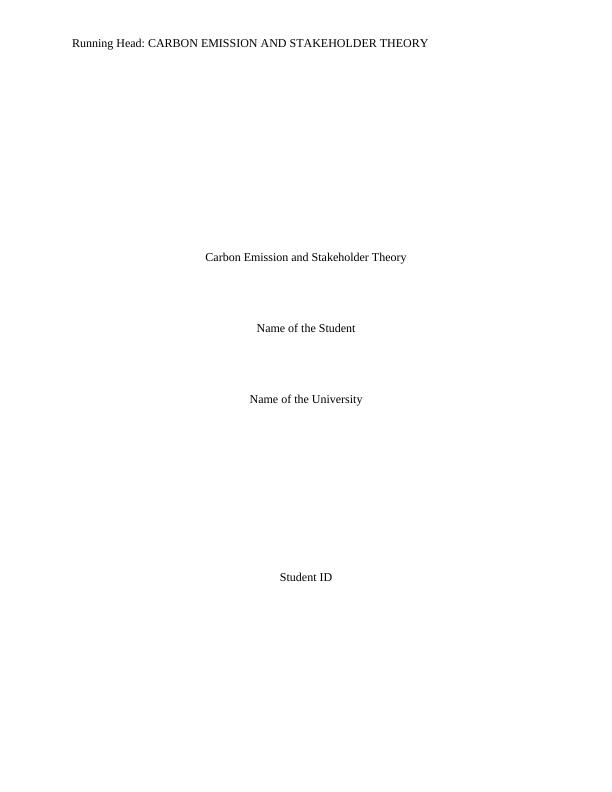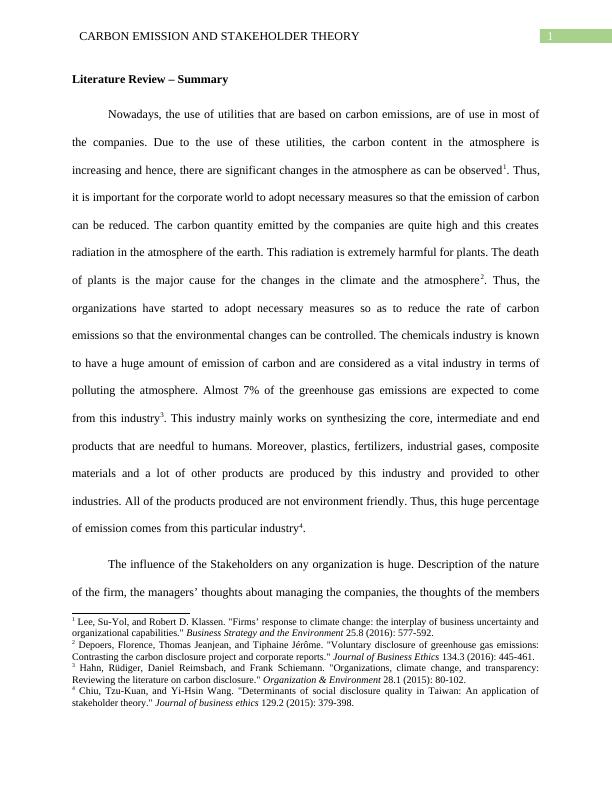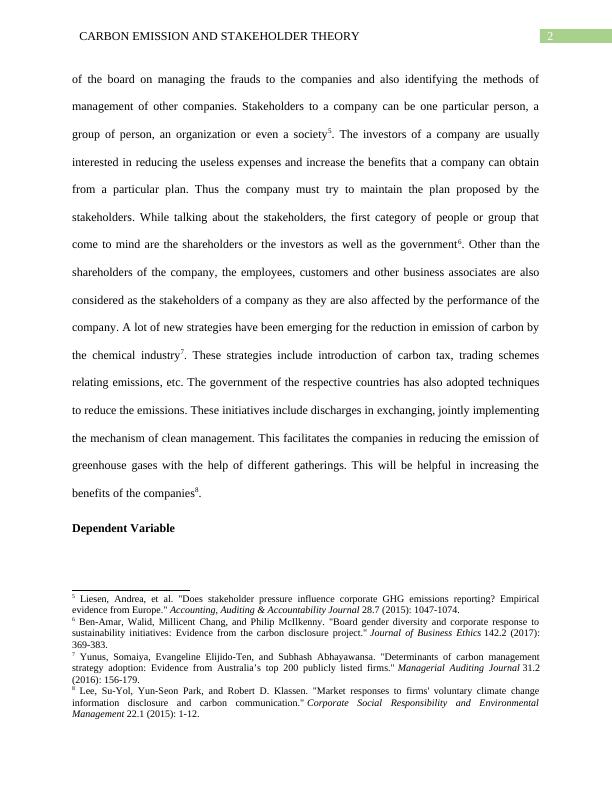Carbon Emission and Stakeholder Theory
Added on 2023-06-10
9 Pages1841 Words221 Views
Running Head: CARBON EMISSION AND STAKEHOLDER THEORY
Carbon Emission and Stakeholder Theory
Name of the Student
Name of the University
Student ID
Carbon Emission and Stakeholder Theory
Name of the Student
Name of the University
Student ID

1CARBON EMISSION AND STAKEHOLDER THEORY
Literature Review – Summary
Nowadays, the use of utilities that are based on carbon emissions, are of use in most of
the companies. Due to the use of these utilities, the carbon content in the atmosphere is
increasing and hence, there are significant changes in the atmosphere as can be observed1. Thus,
it is important for the corporate world to adopt necessary measures so that the emission of carbon
can be reduced. The carbon quantity emitted by the companies are quite high and this creates
radiation in the atmosphere of the earth. This radiation is extremely harmful for plants. The death
of plants is the major cause for the changes in the climate and the atmosphere2. Thus, the
organizations have started to adopt necessary measures so as to reduce the rate of carbon
emissions so that the environmental changes can be controlled. The chemicals industry is known
to have a huge amount of emission of carbon and are considered as a vital industry in terms of
polluting the atmosphere. Almost 7% of the greenhouse gas emissions are expected to come
from this industry3. This industry mainly works on synthesizing the core, intermediate and end
products that are needful to humans. Moreover, plastics, fertilizers, industrial gases, composite
materials and a lot of other products are produced by this industry and provided to other
industries. All of the products produced are not environment friendly. Thus, this huge percentage
of emission comes from this particular industry4.
The influence of the Stakeholders on any organization is huge. Description of the nature
of the firm, the managers’ thoughts about managing the companies, the thoughts of the members
1 Lee, Su‐Yol, and Robert D. Klassen. "Firms’ response to climate change: the interplay of business uncertainty and
organizational capabilities." Business Strategy and the Environment 25.8 (2016): 577-592.
2 Depoers, Florence, Thomas Jeanjean, and Tiphaine Jérôme. "Voluntary disclosure of greenhouse gas emissions:
Contrasting the carbon disclosure project and corporate reports." Journal of Business Ethics 134.3 (2016): 445-461.
3 Hahn, Rüdiger, Daniel Reimsbach, and Frank Schiemann. "Organizations, climate change, and transparency:
Reviewing the literature on carbon disclosure." Organization & Environment 28.1 (2015): 80-102.
4 Chiu, Tzu-Kuan, and Yi-Hsin Wang. "Determinants of social disclosure quality in Taiwan: An application of
stakeholder theory." Journal of business ethics 129.2 (2015): 379-398.
Literature Review – Summary
Nowadays, the use of utilities that are based on carbon emissions, are of use in most of
the companies. Due to the use of these utilities, the carbon content in the atmosphere is
increasing and hence, there are significant changes in the atmosphere as can be observed1. Thus,
it is important for the corporate world to adopt necessary measures so that the emission of carbon
can be reduced. The carbon quantity emitted by the companies are quite high and this creates
radiation in the atmosphere of the earth. This radiation is extremely harmful for plants. The death
of plants is the major cause for the changes in the climate and the atmosphere2. Thus, the
organizations have started to adopt necessary measures so as to reduce the rate of carbon
emissions so that the environmental changes can be controlled. The chemicals industry is known
to have a huge amount of emission of carbon and are considered as a vital industry in terms of
polluting the atmosphere. Almost 7% of the greenhouse gas emissions are expected to come
from this industry3. This industry mainly works on synthesizing the core, intermediate and end
products that are needful to humans. Moreover, plastics, fertilizers, industrial gases, composite
materials and a lot of other products are produced by this industry and provided to other
industries. All of the products produced are not environment friendly. Thus, this huge percentage
of emission comes from this particular industry4.
The influence of the Stakeholders on any organization is huge. Description of the nature
of the firm, the managers’ thoughts about managing the companies, the thoughts of the members
1 Lee, Su‐Yol, and Robert D. Klassen. "Firms’ response to climate change: the interplay of business uncertainty and
organizational capabilities." Business Strategy and the Environment 25.8 (2016): 577-592.
2 Depoers, Florence, Thomas Jeanjean, and Tiphaine Jérôme. "Voluntary disclosure of greenhouse gas emissions:
Contrasting the carbon disclosure project and corporate reports." Journal of Business Ethics 134.3 (2016): 445-461.
3 Hahn, Rüdiger, Daniel Reimsbach, and Frank Schiemann. "Organizations, climate change, and transparency:
Reviewing the literature on carbon disclosure." Organization & Environment 28.1 (2015): 80-102.
4 Chiu, Tzu-Kuan, and Yi-Hsin Wang. "Determinants of social disclosure quality in Taiwan: An application of
stakeholder theory." Journal of business ethics 129.2 (2015): 379-398.

2CARBON EMISSION AND STAKEHOLDER THEORY
of the board on managing the frauds to the companies and also identifying the methods of
management of other companies. Stakeholders to a company can be one particular person, a
group of person, an organization or even a society5. The investors of a company are usually
interested in reducing the useless expenses and increase the benefits that a company can obtain
from a particular plan. Thus the company must try to maintain the plan proposed by the
stakeholders. While talking about the stakeholders, the first category of people or group that
come to mind are the shareholders or the investors as well as the government6. Other than the
shareholders of the company, the employees, customers and other business associates are also
considered as the stakeholders of a company as they are also affected by the performance of the
company. A lot of new strategies have been emerging for the reduction in emission of carbon by
the chemical industry7. These strategies include introduction of carbon tax, trading schemes
relating emissions, etc. The government of the respective countries has also adopted techniques
to reduce the emissions. These initiatives include discharges in exchanging, jointly implementing
the mechanism of clean management. This facilitates the companies in reducing the emission of
greenhouse gases with the help of different gatherings. This will be helpful in increasing the
benefits of the companies8.
Dependent Variable
5 Liesen, Andrea, et al. "Does stakeholder pressure influence corporate GHG emissions reporting? Empirical
evidence from Europe." Accounting, Auditing & Accountability Journal 28.7 (2015): 1047-1074.
6 Ben-Amar, Walid, Millicent Chang, and Philip McIlkenny. "Board gender diversity and corporate response to
sustainability initiatives: Evidence from the carbon disclosure project." Journal of Business Ethics 142.2 (2017):
369-383.
7 Yunus, Somaiya, Evangeline Elijido-Ten, and Subhash Abhayawansa. "Determinants of carbon management
strategy adoption: Evidence from Australia’s top 200 publicly listed firms." Managerial Auditing Journal 31.2
(2016): 156-179.
8 Lee, Su‐Yol, Yun‐Seon Park, and Robert D. Klassen. "Market responses to firms' voluntary climate change
information disclosure and carbon communication." Corporate Social Responsibility and Environmental
Management 22.1 (2015): 1-12.
of the board on managing the frauds to the companies and also identifying the methods of
management of other companies. Stakeholders to a company can be one particular person, a
group of person, an organization or even a society5. The investors of a company are usually
interested in reducing the useless expenses and increase the benefits that a company can obtain
from a particular plan. Thus the company must try to maintain the plan proposed by the
stakeholders. While talking about the stakeholders, the first category of people or group that
come to mind are the shareholders or the investors as well as the government6. Other than the
shareholders of the company, the employees, customers and other business associates are also
considered as the stakeholders of a company as they are also affected by the performance of the
company. A lot of new strategies have been emerging for the reduction in emission of carbon by
the chemical industry7. These strategies include introduction of carbon tax, trading schemes
relating emissions, etc. The government of the respective countries has also adopted techniques
to reduce the emissions. These initiatives include discharges in exchanging, jointly implementing
the mechanism of clean management. This facilitates the companies in reducing the emission of
greenhouse gases with the help of different gatherings. This will be helpful in increasing the
benefits of the companies8.
Dependent Variable
5 Liesen, Andrea, et al. "Does stakeholder pressure influence corporate GHG emissions reporting? Empirical
evidence from Europe." Accounting, Auditing & Accountability Journal 28.7 (2015): 1047-1074.
6 Ben-Amar, Walid, Millicent Chang, and Philip McIlkenny. "Board gender diversity and corporate response to
sustainability initiatives: Evidence from the carbon disclosure project." Journal of Business Ethics 142.2 (2017):
369-383.
7 Yunus, Somaiya, Evangeline Elijido-Ten, and Subhash Abhayawansa. "Determinants of carbon management
strategy adoption: Evidence from Australia’s top 200 publicly listed firms." Managerial Auditing Journal 31.2
(2016): 156-179.
8 Lee, Su‐Yol, Yun‐Seon Park, and Robert D. Klassen. "Market responses to firms' voluntary climate change
information disclosure and carbon communication." Corporate Social Responsibility and Environmental
Management 22.1 (2015): 1-12.

End of preview
Want to access all the pages? Upload your documents or become a member.
Related Documents
Human Activities and Climate Change Thesis 2022lg...
|7
|1282
|28
Reducing Emission of Carbon Compounds: A Study on Exxon Mobil Corporationlg...
|9
|1883
|151
To what extent is Climate Change a result of human activities?lg...
|6
|1421
|63
Carbon Disclosure Determinants in Companieslg...
|12
|2155
|146
Carbon Emissions and Climate Change Impact on Businesseslg...
|13
|2707
|254
Climate Action Plan | Sustainability and Future of Fashionlg...
|5
|733
|19
